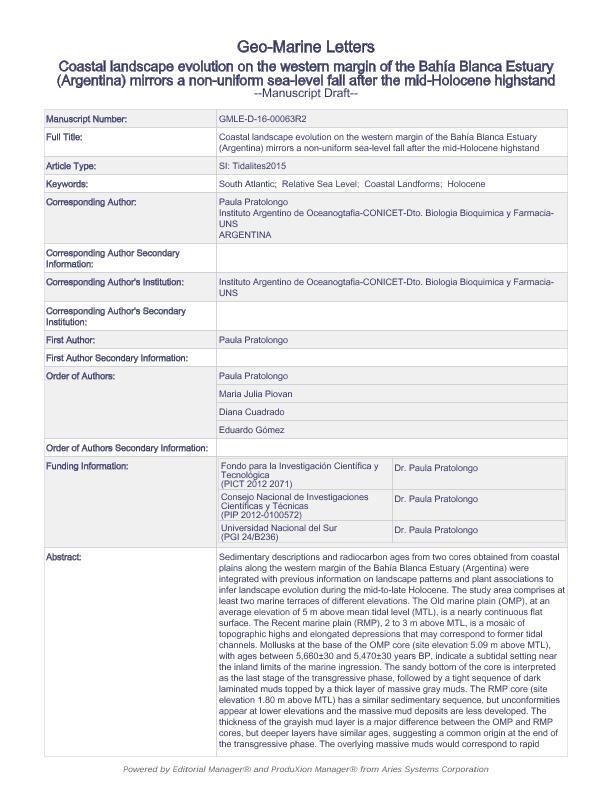Mostrar el registro sencillo del ítem
dc.contributor.author
Zapperi, Georgina María

dc.contributor.author
Pratolongo, Paula Daniela

dc.contributor.author
Piovan, María Julia

dc.contributor.author
Marcovecchio, Jorge Eduardo

dc.date.available
2017-10-05T15:21:11Z
dc.date.issued
2016-05
dc.identifier.citation
Zapperi, Georgina María; Pratolongo, Paula Daniela; Piovan, María Julia; Marcovecchio, Jorge Eduardo; Benthic-Pelagic Coupling in an Intertidal Mudflat in the Bahía Blanca Estuary (SW Atlantic); Coastal Education & Research Foundation; Journal Of Coastal Research; 32; 3; 5-2016; 629-637
dc.identifier.issn
0749-0208
dc.identifier.uri
http://hdl.handle.net/11336/25957
dc.description.abstract
En este trabajo se evaluó el acople bentónico-pelágico en un estuario somero, eutrófico y con alta turbidez del SO Atlántico. Las características del hábitat y la composición de las comunidades bentónicas, llevan a definir dos subsistemas en las planicies de marea: el cangrejal y el poliquetal. Se estudiaron parámetros fisicoquímicos como la turbidez, la concentración de nutrientes inorgánicos disueltos y la clorofila a (Cl-a) en la columna de agua. Las variaciones encontradas fueron relacionadas con cambios estacionales en la abundancia y composición de las comunidades macrobentónicas, así como también con los flujos de nutrientes (que se estimaron con incubaciones en microcosmos). El pico de clorofila a en la columna de agua, ocurrió en Julio, luego de que la turbidez alcanzara su valor mínimo en Junio. La concentración de todos los nutrientes disueltos disminuyó luego del pico de Cl-a. El flujo bentónico de NH+ 4 hacia la columna fue muy elevado luego de la floración de diatomeas en el poliquetal, mientras que fue secuestrado por los sedimentos del cangrejal. Ambos subsistemas fueron sumideros de NO -3 + NO -2 antes de la floración, y luego de ésta los flujos se invirtieron. El cangrejo cavador (Neohelice granulata) y Laeonereis acuta fueron las especies mayormente representadas en los dos subsistemas. La densidad de L. acuta en el poliquetal fue mayor en Junio, mientras que la mayor densidad de N. granulata en el cangrejal fue en Diciembre. Estos cambios en la abundancia coinciden con cambios en la dirección o magnitud de los flujos bentónicos. Los resultados sugieren que el acople bentónico pelágico, mediado por la actividad biológica, podría jugar un rol muy importante en la disminución de la turbidez que permite la floración del fitoplancton. El acople local entre la remineralización en la superficie de los sedimentos luego del asentamiento de la materia orgánica generada por la floración, con los flujos bentónicos de nutrientes disueltos que fueron regenerados, ayuda a mantener la productividad primaria del estuario.
dc.description.abstract
Benthic-pelagic coupling was evaluated in a shallow, turbid, and nutrient-enriched estuary in the SW Atlantic. We analyzed the annual trends in turbidity, nutrients, and chlorophyll a (Chl a) concentration in the water column and related those changes to benthic fluxes of dissolved inorganic nutrients, estimated through microcosm incubation experiments, as well as seasonal variations in the abundance and composition of macrobenthic communities. The intertidal mudflats of the estuary are characterized by the presence of two subsystems defined by their macroecological features: crab beds, steep areas dominated by the burrowing crab, and Laeonereis flats, plain areas with low crab burrow density. Peak Chl a concentration in the water column occurred in July after turbidity reached its minimum value in June. Dissolved nutrients decreased after the peak of Chl a. Benthic fluxes of NH+ 4 into the water column were very high after the diatom bloom in the Laeonereis flats, whereas the crab beds performed as sinks. Both subsystems were sinks of NO -3 + NO -2 before the bloom, and fluxes reversed in the postbloom period. The crab Neohelice granulata and the polychaete Laeonereis acuta were the most represented macrobenthic species in both subsystems. Density of L. acuta in Laeonereis flats was highest in June, whereas that of N. granulata in the crab beds was highest in December. These changes in abundance coincide with changes in benthic fluxes. These results suggest that benthic-pelagic coupling, mediated by biological activity, may play a significant role in creating the window of lower turbidity that allows phytoplankton blooms. As the bloom develops, dissolved nutrients in the water column are consumed, and organic matter is produced. As a counterpart, the local coupling between remineralization in the sediment surface and the benthic flux to the water column as dissolved nutrients allows the recovery of nutrient levels and supports primary production in the forthcoming cycle.
dc.format
application/pdf
dc.language.iso
eng
dc.publisher
Coastal Education & Research Foundation

dc.rights
info:eu-repo/semantics/openAccess
dc.rights.uri
https://creativecommons.org/licenses/by-nc-sa/2.5/ar/
dc.subject
Nutrient Fluxes
dc.subject
Benthic Communities
dc.subject
Phytoplankton
dc.subject
Shallow And Turbid Systems
dc.subject.classification
Oceanografía, Hidrología, Recursos Hídricos

dc.subject.classification
Ciencias de la Tierra y relacionadas con el Medio Ambiente

dc.subject.classification
CIENCIAS NATURALES Y EXACTAS

dc.title
Benthic-Pelagic Coupling in an Intertidal Mudflat in the Bahía Blanca Estuary (SW Atlantic)
dc.type
info:eu-repo/semantics/article
dc.type
info:ar-repo/semantics/artículo
dc.type
info:eu-repo/semantics/publishedVersion
dc.date.updated
2017-09-19T14:37:48Z
dc.identifier.eissn
1551-5036
dc.journal.volume
32
dc.journal.number
3
dc.journal.pagination
629-637
dc.journal.pais
Estados Unidos

dc.journal.ciudad
Florida
dc.description.fil
Fil: Zapperi, Georgina María. Consejo Nacional de Investigaciones Científicas y Técnicas. Centro Científico Tecnológico Conicet - Bahía Blanca. Instituto Argentino de Oceanografía. Universidad Nacional del Sur. Instituto Argentino de Oceanografía; Argentina
dc.description.fil
Fil: Pratolongo, Paula Daniela. Consejo Nacional de Investigaciones Científicas y Técnicas. Centro Científico Tecnológico Conicet - Bahía Blanca. Instituto Argentino de Oceanografía. Universidad Nacional del Sur. Instituto Argentino de Oceanografía; Argentina
dc.description.fil
Fil: Piovan, María Julia. Consejo Nacional de Investigaciones Científicas y Técnicas. Centro Científico Tecnológico Conicet - Bahía Blanca. Instituto Argentino de Oceanografía. Universidad Nacional del Sur. Instituto Argentino de Oceanografía; Argentina
dc.description.fil
Fil: Marcovecchio, Jorge Eduardo. Consejo Nacional de Investigaciones Científicas y Técnicas. Centro Científico Tecnológico Conicet - Bahía Blanca. Instituto Argentino de Oceanografía. Universidad Nacional del Sur. Instituto Argentino de Oceanografía; Argentina
dc.journal.title
Journal Of Coastal Research

dc.relation.alternativeid
info:eu-repo/semantics/altIdentifier/doi/https://doi.org/10.2112/JCOASTRES-D-14-00064.1
Archivos asociados
